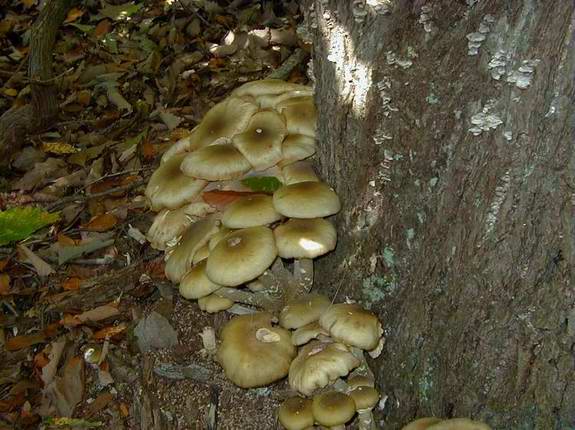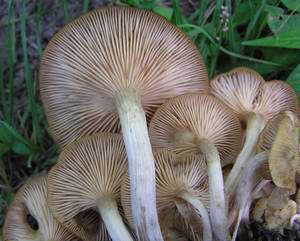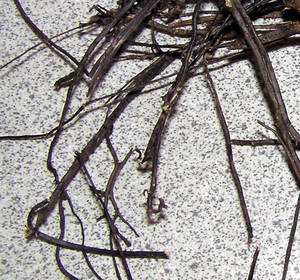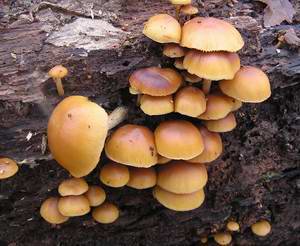|
Return to Hiker's Notebook Home Page
Common Name: Honey Mushroom, bootlace fungus, stump mushroom - The variegated yellowish brown hues of the cap have areas that are similar in coloration to honey. The bootlace name describes the black, elongated outgrowths called rhizomorphs that extend from the mycelium (the underground body of the fungus) as it propagates vegetatively.
Scientific Name: Armillaria mellea - The generic name is derived from the Latin words armilla which means ring-shaped and aria which is a word signifying a connection. This refers to the annular ring on the upper stalk of the mushrooms of this genus that is "ring-shaped" and connected to the stalk. Mellea is derived from mel, the Latin word for honey. Alternatively named Armillariella mellea.
The honey mushroom was once considered to be a singular though polymorphic species (polymorphism applies to an organism as an expression of its capability for wide variation) and its genus Armillaria was once comprised of any white-spored mushroom of the agaric family (Agaricaceae) with attached gills and an annular ring on the stem, approximately 250 species. Several decades ago A. mellea and its generic assignation became subject to the tumult in the field of mycology as a better understanding of taxonomy based on experimentation and DNA analysis became manifest. The Armillaria genus was reduced to only those mushrooms that produced long, stringy root-like structures called rhizomorphs; the other mushrooms that had been in the genus were renamed and reclassified to other genera.
The
honey mushroom was originally assigned to a new genus Armillariella
(which is still in use in some texts). However, owing in part to its
polymorphism, it came under scrutiny and research to ascertain the nature of
the species was undertaken by mycologists in the 1970's. Since the external
features of mushroom morphology are inadequate to distinguish variance, a much
more laborious process must be employed. In the case of the honey mushroom,
that consisted of taking individual spores from different mushrooms and
placing them together is a petri dish filled with agar to observe the
resultant growth patterns. If the spores were from different species, the
resulting growth was white and fluffy indicating no genetic communication; if
the spores were from the same s
The honey mu Armillaria mellea rhizomorphs fungus outward from the original infestation. The rhizomorph hyphae transport nutrients from one location to another; the honey fungus can thus extend its range through an area devoid of nutrition to a new food source, such as an adjacent tree or stump. Rhizomorphs travel just below the surface of the ground until they reach the roots of an adjacent tree. An infected tree will die once the fungus has girdled it; the vascular system of trees depends on a flow of water and minerals up the inner part of the bole called the xylem and the flow of nutrients from the leaves down the outermost layers below the bark called the phloem - when a tree is girdled the outer layer flow of nutrients is curtailed.
Foxfire is a name given to the observed phenomenon of decaying wood that glows in the dark; "fox" connotes not only the woodland habitat of the light (fire) but also confusion: the fox is sly and cunning and foxfire is perplexing. This ethereal nocturnal glow is caused by bioluminescence, the production and emission of light by a living organism in converting chemical energy to light energy. The pigment lucifern (from the Latin lucifer, meaning light-bearing) reacts with the enzyme luciferase, ATP (adenocyne triphosphate) and oxygen to produce light. Though there are a number of fungi that luminesce, the honey fungus is the most extensive and notable (in some references, the glow of A. mellea is defined as foxfire). This is because the rhizomorphs of the honey fungus extend under the bark of an infested tree and the extending hyphae permeate the wood as it decays Thus the wood itself appears to glow. Other fungi that glow in the dark like the Jack O' Lantern (Omphalotus olearius) are in the form of a mushroom fruiting body that grows as an entity distinct from the wood. It is thought that the bioluminescence of fungi evolved to attract insects to the fruiting body to assist in spore dispersal.
The honey mushroom is also the "humongous fungus" that has periodically risen to national prominence. It started in Michigan in 1992, when researchers evaluating the biological effects of the installation of an extremely low frequency (ELF) transmitter for submarine communication mapped out the geographical dispersion of a type of honey fungus (A. bulbosa). They found that it extended over an area of 15 hectares (37 acres) and estimated that it weighed about 100 tons and was about 1500 years old. Later in 1992 an even larger honey fungus (A. ostoyae) of 600 hectares was found in southwestern Washington. The current record is held by the state of Oregon, where a honey fungus (also A. ostoyae) of 900 hectares (3.4 square miles) was discovered in August, 2000. It is estimated that this fungus is at least 2, 400 years; at an assumed steady state rate of rhizomorph growth of 1 meter per year, it would take that long for it to reach its current extension. It could be much older. Since it is 60 times larger than the Michigan fungus, its weight by extrapolation is about 6,000 tons, about 5 times the estimated weight of the giant redwood (Sequoiadendron giganteum). This gives the honey fungus the dubious distinction of being the largest and oldest living thing on earth.
The honey mushroom is edible and is generally classified in mushroom field guides as "choice, with caution." The caveat enjoins the mycophagist to cook the raw mushroom thoroughly before eating; even then, it is known to cause gastrointestinal discomfort in some people since it is . But the real caution is that there is a deadly mushroom with very similar characteristics; the Galerina autumnalis is commonly known as the Deadly Galerina because it contains the same toxins as the Destroying Angel (Amanita virosa).
Galerina Autumnalis -Deadly Galerina |

 pecies
and compatible genetically, the growth was brown and sometimes produced
rhizomorphs. Using this method, the honey mushroom was found to consist of
five different species native to Europe and ten different species native to
North America. The distinctions between the species are generally not manifest
in any significant physical differences except one, the presence of a ring on
the stalk. The honey mushroom A. mellea has a ring on the stalk and a
viscid or sticky cap. The "ringless honey mushroom" A. tabescens
(tabescent means wasting away) does not have a ring and has a dry, scaly cap.
pecies
and compatible genetically, the growth was brown and sometimes produced
rhizomorphs. Using this method, the honey mushroom was found to consist of
five different species native to Europe and ten different species native to
North America. The distinctions between the species are generally not manifest
in any significant physical differences except one, the presence of a ring on
the stalk. The honey mushroom A. mellea has a ring on the stalk and a
viscid or sticky cap. The "ringless honey mushroom" A. tabescens
(tabescent means wasting away) does not have a ring and has a dry, scaly cap.
 shroom
is one of the most damaging pathogenic fungal species; it can rapidly infest
and kill trees over an extended area. The mycelial body of the fungus is
underground, subsisting among the roots of plants. Growth occurs by root-like
tendrils called hyphae that extend vegetatively to exploit surrounding
resources. In the case of the honey fungus, these hyphae intertwine like the
strands of rope and form a protective black rind so that the resulting
structure is robust and penetrating. This filamentous structure is called a
rhizomorph from the Greek rhiza meaning root and morphus meaning
form; it has a root-like form. Rhizomorphs can grow as much as a meter per
year, extending the range of the
shroom
is one of the most damaging pathogenic fungal species; it can rapidly infest
and kill trees over an extended area. The mycelial body of the fungus is
underground, subsisting among the roots of plants. Growth occurs by root-like
tendrils called hyphae that extend vegetatively to exploit surrounding
resources. In the case of the honey fungus, these hyphae intertwine like the
strands of rope and form a protective black rind so that the resulting
structure is robust and penetrating. This filamentous structure is called a
rhizomorph from the Greek rhiza meaning root and morphus meaning
form; it has a root-like form. Rhizomorphs can grow as much as a meter per
year, extending the range of the 